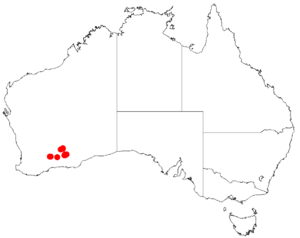Acacia kerryana facts for kids
Quick facts for kids Acacia kerryana |
|
|---|---|
| Conservation status | |
| Scientific classification | |
| Genus: |
Acacia
|
| Species: |
kerryana
|
 |
|
| Occurrence data from AVH | |
Acacia kerryana is a special kind of shrub that belongs to a large group of plants called Acacias. It grows only in the southwestern part of Australia. This means it's endemic to that area, so you won't find it naturally anywhere else in the world!
What it Looks Like
This low, spreading shrub usually grows to be about 0.3 to 1 metre (1 to 3 ft) tall. Its branches are a bit bendy and have slight ridges. They are often covered with short, stiff, sharp hairs.
The leaves of Acacia kerryana are always green. They are smooth and don't have stalks. These special leaves, called phyllodes, are like flattened stems that do the job of leaves. They are about 8 to 16 cm (3.1 to 6.3 in) long and very thin, only 0.4 to 0.6 mm (0.016 to 0.024 in) wide. Each phyllode has eight raised lines running along it.
This plant blooms with yellow flowers from October to February. Its simple flower clusters grow in pairs or groups of three where the leaves meet the stem. These flower heads are shaped like small cylinders. They are about 6 to 9 mm (0.24 to 0.35 in) long and 3 to 4 mm (0.12 to 0.16 in) wide. The flowers are packed fairly close together and are a light golden color.
After the flowers, twisted, flat seed pods form. They are thin and look like paper. These pods can be up to 8.5 cm (3.3 in) long and 2 mm (0.079 in) wide.
How it Got its Name
A botanist named Bruce Maslin first officially described this plant in 1982. He wrote about it in a scientific journal called Nuytsia.
Later, in 2003, another botanist named Leslie Pedley changed its name to Racosperma kerryanum. But then, in 2006, it was moved back to the Acacia group. So, its official name is Acacia kerryana again.
Where it Grows
Acacia kerryana naturally grows in the southern Goldfields region of Western Australia. You can find it on flat areas and low, rocky hills. It prefers to grow in soils that are sandy or clay-sandy, often with granite rocks nearby.
This plant is found in different spots between Kambalda in the north and Norseman in the south. It usually grows as part of low, open shrubland areas.


